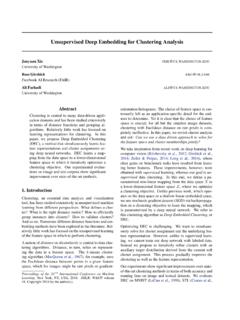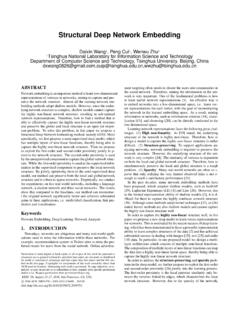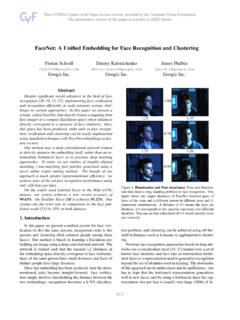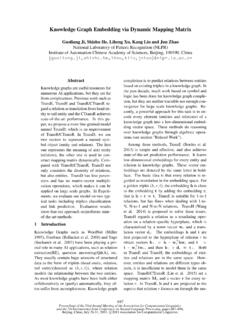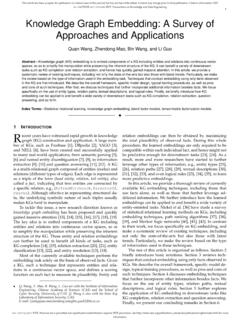Transcription of Sobolev spaces and embedding theorems - ICMC
1 Sobolev spaces and embedding theorems Tomasz Dlotko, Silesian University, Poland Contents 1. Introductory remarks 1. Domains 1. Generalized derivatives 2. Lp spaces 3. 2. Sobolev spaces 5. Definition of the Sobolev spaces 5. Dense subsets and approximation in Sobolev spaces 6. 3. Embeddings of Sobolev spaces 7. Continuous embeddings of Sobolev spaces 7. Compact embeddings of Sobolev spaces 9. 4. Applications of Sobolev spaces 10. Closedness of differential operators in Sobolev spaces 11. The Lax-Milgram lemma 12. 5. References 15. 1. 1. Introductory remarks In this initial part of the lecture an auxiliary material needed in the main body will be presented. The following notions will be discussed: Classes of domains with boundaries satisfying cone condition, Lipschitz condition or of the class C k . Also an extension property allowing to restrict most proofs to the case of the whole of Rn will be discussed. Generalized ( Sobolev , weak) derivatives.
2 Their properties, comparison with distributional deriva- tives. Basic properties of Lp spaces and the space L1loc . Inequalities. Poincare inequality and interpolation inequality. The theory of Sobolev spaces has been originated by Russian mathematician Sobolev around 1938. [SO]. These spaces were not introduced for some theoretical purposes, but for the need of the theory of partial differential equations. They are closely connected with the theory of distributions, since elements of such spaces are special classes of distributions. In order to discuss the theory of Sobolev spaces we shall start with some simple basic notions that are necessary for introducing and studying these spaces . The first object that we need to discuss is the domain in Rn and the possible classes of the domains that are considered in the theory of Sobolev spaces . This is important, since elements of such spaces are functions defined on the domains in Rn with, say, real values (or complex values).
3 Domains. By a domain in Rn we understand an open set in n dimensional real Euclidean space Rn . There are several classes of domains, described in terms of the smoothness of their boundary considered in this theory. We will concentrate our description on the case of bounded domains , when the definitions are simpler pointing to [AD] for the case of not necessarily bounded . The three classes of domains are most often considered;. Domains Rn having the cone property. Domains having the local Lipschitz property. Domains having the C m regularity property. We start with the description of the first property. Given a point x Rn an open ball B1 with center in x and an open ball B2 not containing x the set Cx = B1 {x + (y x) : y B2 , > 0} is called a finite cone in Rn having vertex at x. By x + C0 = x + y : y C0 we will denote the finite cone with vertex in x obtained by parallel translation of a finite cone C0 with vertex at 0. Definition 1.
4 Has the cone property if there exists a finite cone C such that each point x is the vertex of a finite cone Cx contained in and congruent to C. (That means, Cx is obtained from C by a rigid motion). Definition 2. has a locally Lipschitz boundary, if each point x on the boundary of has a neighbourhood Ux such that bdry Ux is the graph of a Lipschitz continuous function. Definition 3. A bounded domain Rn is called a domain of class C k , 0 k , provided that the following conditions are satisfied: There is a finite open cover of the boundary , N. X. Vr (1). r=1. and is a such that the intersection Vr can be described as: xn = gr (x0 ) where gr C k ( ). cube {|xj | < a, j = 1, , n 1}. 2. There is real b > 0, such that: {x : gr (x0 ) b < xn < gr (x0 ), x0 } Rn \ (2). also {x : gr (x0 ) < xn < gr (x0 ) + b, x0 } . (3). With the exception of the cone property all the other properties require to lie on one side of its boundary. It can be shown, that the following connections between these conditions are valid.
5 M C regularity property (m 1) . local Lipschitz property (4).. cone property. Most of the important properties of the Sobolev spaces require only the assumption that satisfies the cone condition. One more property of the domains is very important in the considerations. This is the, so called, extension property. This property will be described below. We set the definition first: Definition 4. Let be a domain in Rn . For given numbers m and p a linear operator E mapping W m,p ( ). into W m,p (Rn ) is called an (m, p) -extension operator for provided that: (. Eu(x) = u(x) in , (5). u W m,p ( ) K(m,p) kEukW m,p (Rn ) KkukW m,p ( ) . The existence of an (m, p)-extension operator for a domain guarantees that W m,p ( ) inherits many nice properties possessed by W m,p (Rn ). If, for example, the embedding W m,p (Rn ) Lq (Rn ) is known to hold, similar property will be true for the spaces over . We will quote below a theorem justifying existence of such extension operator: Theorem 1.)
6 Let be either a half-space in Rn or a bounded domain in Rn having the C m -regularity property, then for any positive integer m there exists an extension operator E for . The proof of this result can be found in [AD], and it uses the notion of the partition of unity. Generalized derivatives. By a space L1loc ( ) we understand the set of all Lebesgue measurable in functions having absolute value integrable on each compact subset of the set . By a multi-index we understand a vector ( 1 , , n ) having natural components i . We set | | = 1 + + n . We also define the partial derivative | | . D = . (6). x . 1. 1. x . n n We are now able to define the notion of weak derivative. Definition 5. A locally integrable function v (element of L1loc ( )) is called the -th weak derivative of u L1loc ( ), if it satisfies Z Z. | |. vdx = ( 1)| | uD dx for all C0 ( ). (7).. Note that the weak derivative is uniquely determined up to the set of measure zero.
7 We call a function weakly differentiable if all its partial derivatives of first order exist and k times weakly differentiable if all its weak derivatives exist for orders up to and including k. Denote the linear space of k times weakly differentiable functions by W k ( ). Clearly C k ( ) W k ( ). The concept of weak derivatives then extends the concept of the classical derivatives. 3. There is no time here to introduce the (more general) notion of the distributional derivative. The weak derivative is a special kind of the distributional derivative. Lp spaces . Let be a bounded domain in Rn . By a measurable function we shall mean an equivalent class of measurable functions on which differ only on a subset of measure zero. The supremum and infimum of a measurable function will be understood as the essential supremum or essential infimum respectively. Let p 1, by Lp ( ) we denote the Banach space consisting of all measurable functions on thats p powers are integrable.
8 The norm in Lp ( ) is defined by: Z p1. p kukLp ( ) = |u| dx . (8).. When p = , we set: kukL ( ) = esssup|u|. (9). There are a few elementary inequalities of the importance for the future that we shall quote now. The first is called Young inequality: ap bq ab + , (10). p q which holds for positive reals a, b, p, q that satisfy additionally 1 1. + =1 (11). p q (the, so called, condition of Ho lder conjugacy). With the same exponents as above the Ho lder inequality is satisfied: Z. uvdx kukLp ( ) kvkLq ( ) . (12).. It is a consequence of the Young's inequality. As a consequence of the Ho lder inequality the interpolation inequality for Lp spaces is satisfied: kukLq ( ) kuk Lp ( ) kuk1 . Lr ( ) , (13). 1 (1 ). valid for u Lr ( ) with p q r and q = p + r . The further and more involved inequality we can face is the, so called, Poincare inequality. Several versions of it are known, so we can quote only one of the best known among them.
9 Lemma 1. Let be a domain with continuous boundary. Let 1 p < . Then for any u W 1,p ( ): Z Z p Z Xn . u p u(x) 1 . u(y)dy dx c . | | xi dx. (14). i=1. Proof. The proof is equivalent with showing that: Z Z X n . u p |u(x)|p dx c dx, (15).. i=1 xi for the W 1,p ( ) functions having zero main value. Assume, at contrary, that there exists a sequence {uk } W 1,p ( ), such that kuk kW 1,p ( ) = 1 and Z Z X n . uk p p 1 = kuk kW 1,p ( ) p |uk | dx > k dx. (16).. i=1 xi 4. Equivalently, this can be written as: Z X n . uk p 1.. xi dx < k . (17). i=1. Using the result of compactness of the embedding W 1,p ( ) Lp ( ) (that can be proved later), we are thus able to find a subsequence {ukl } convergent in Lp ( ) to u. Thanks to (17) we have also, ukl u in W 1,p ( ). u But this same estimate shows also, that x i = 0 in . It can be shown, that u = const. in . Because of the zero mean (the property preserved from the sequence) u must be equal zero ( in ).
10 This contradicts the property kukW 1,p ( ) = 1.. Similar estimate, even beter known, is valid for the functions equal zero on , more precisely belonging to the space W01,p ( ). For more general versions of the Poincae inequality consult [ZI], Finally we present an elementary proof of a version of the interpolation inequality. We have: Theorem 2. Let u W0k,p ( ). Then, for any > 0, 0 < | | < k | |. kD ukLp ( ) kukW k,p ( ) + C | | k kukLp ( ) , (18). where C = C(k). Proof. We establish (18) for the case | | = 1, k = 2. The rest can be obtained through a suitable induction argument. Assume at first that u C02 (R) and consider an interval (a, b) of the length b a = . For x0 . (a, a + 3 ), x00 (b 3 , b), by the mean value theorem, . u(x0 ) u(x00 ) 3. |u0 (x )| = (|u(x0 )| + |u(x00 )|), (19). x0 x00. Rx for some x (a, b). Consequently, for any x (a, b), u0 (x) = u0 (x ) + x u (s)ds, so that Z b 3. |u0 (x)| (|u(x0 )| + |u(x00 )|) + |u00 |dx.

